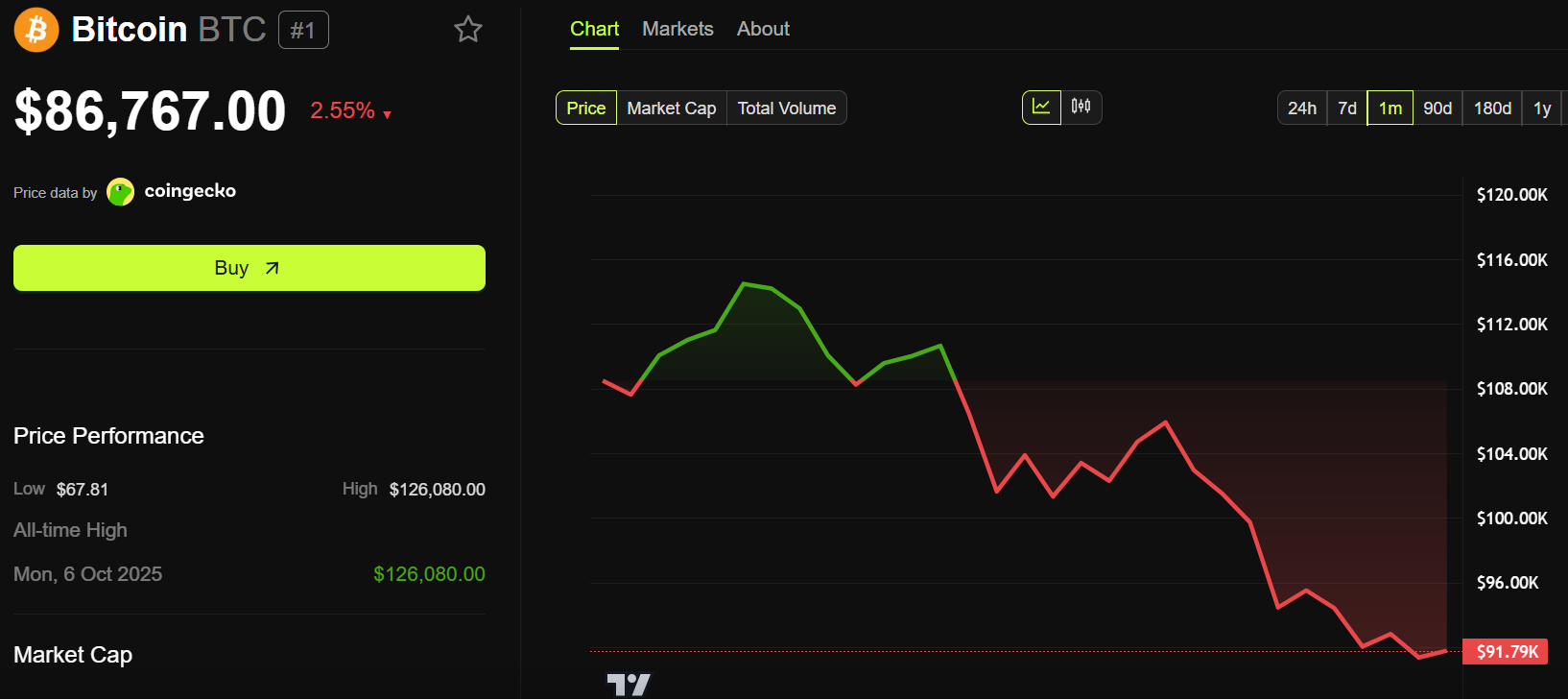Whale Dump Meets Quantum Panic: Bitcoin Slips to $86,000 and Blows $220 Million Longs
0
0

Bitcoin fell below $87,000 on November 20, 2025, amid a storm of quantum security fears and $1.3 billion whale capitulation. In the process, it blew almost $220 million in long positions out of the water.
This sharp decline extended a two-day pattern of Asian rebounds erased by US market sell-offs. Traders struggled with mixed signals from institutional buyers and a wave of retail panic.
Quantum Computing Panic Triggers Market-Wide Fear
The latest sell-off accelerated after billionaire Ray Dalio raised concerns about Bitcoin’s vulnerability to advances in quantum computing.
His remarks reignited debate in the cryptocurrency community, focusing attention on cryptographic security risks.
“I have a small percentage of Bitcoin I’ve had forever, like 1% of my portfolio. I think the problem with Bitcoin is that it’s not going to be a reserve currency for major countries because it can be tracked, and it could be conceivably controlled, hacked, and so on,” Ray Dalio stated.
However, market analysts pushed back on the quantum panic narrative. Mel Mattison, a financial analyst, argued that these fears are overblown and overlook Bitcoin’s strong cryptography in comparison to traditional banks.
“If people are selling BTC on quantum decryption, they should be selling the hell out of every bank on the planet. JPM should be down 20%. Every account will be hackable. BTC is SHA-256, which is tougher than RSA,” Mel Mattison countered.
This debate reflects a significant divide in how investors assess long-term tech risks. While Dalio highlighted theoretical vulnerabilities as quantum computing develops, critics point out that Bitcoin’s SHA-256 provides stronger security than the RSA standard used by most banks.
If quantum computers pose a threat to Bitcoin, global banking may face even greater risks.
Early Bitcoin Adopter Exits With $1.3 Billion Sale
Adding to quantum security worries, blockchain analytics firm Arkham reported a massive capitulation. Owen Gunden, an early Bitcoin adopter who accumulated holdings since 2011, sold his entire 11,000 BTC for about $1.3 billion.
Gunden’s exit came at a precarious time for sentiment. According to data from BeInCrypto, Bitcoin was trading at $86,767 at the latest update, down 2.55% over 24 hours.
 Bitcoin (BTC) Price Performance. Source: BeInCrypto
Bitcoin (BTC) Price Performance. Source: BeInCrypto
This whale’s decision to sell after 14 years highlights a shift from the usual long-term holding mentality. The reasons are unclear, whether profit-taking, rebalancing, or concerns about Bitcoin’s outlook.
Still, the sale injected extra supply into an oversold market and deepened the price slide.
Massive Liquidation Cascade Accelerates Decline
Quantum fears and whale selling sparked a large liquidation cascade across exchanges. CoinGlass data shows over $910 million in crypto positions were liquidated in 24 hours, forcing out 222,008 traders.
During one hour in early US trading, long liquidations spiked to $264.79 million while shorts hit $256.44 million.
 Crypto Liquidations in the Last Hour. Source: Coinglass
Crypto Liquidations in the Last Hour. Source: Coinglass
These forced closures highlight the significant leverage in crypto markets and how quickly positions can unwind during sharp market moves.
This cascade revealed structural weaknesses in crypto derivatives as well. As Bitcoin dropped from above $91,000 to $86,000 in 48 hours, leveraged traders faced margin calls and had their positions automatically closed.
This automated selling created further price declines and additional liquidations, fueling a cycle of volatility.
Institutional Buyers Return Despite Retail Panic
Despite the sell-off, US Bitcoin ETFs (exchange-traded funds) saw $75 million in net inflows on Wedneday, ending a five-day outflow streak.
BlackRock’s IBIT and Grayscale’s mini ETF accounted for all the inflows, showing that some institutional investors viewed the dip as a buying opportunity.
Yet, sentiment among ETF issuers remained mixed. VanEck, Fidelity, and other large issuers reported flat or negative flows, indicating cautious optimism.
 Bitcoin ETF Flows on November 19. Source: Farside Investors
Bitcoin ETF Flows on November 19. Source: Farside Investors
This split highlights the mixed outlook in Bitcoin markets. Some institutions view the current levels as valuable, while others hesitate due to near-term uncertainties.
The collision of whale sales, quantum security concerns, and institutional buying has driven sharp volatility. Investors now face the question of whether the quantum narrative signals real risk or simply profit-taking after Bitcoin’s rally this year.
The next days will show whether institutional support can hold prices steady or if more declines lie ahead as the market processes these risks and the influx of long-term holder supply.
0
0
 Manage all your crypto, NFT and DeFi from one place
Manage all your crypto, NFT and DeFi from one placeSecurely connect the portfolio you’re using to start.







